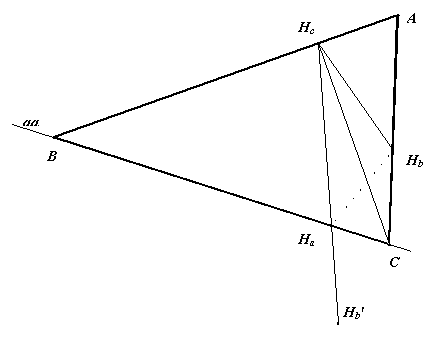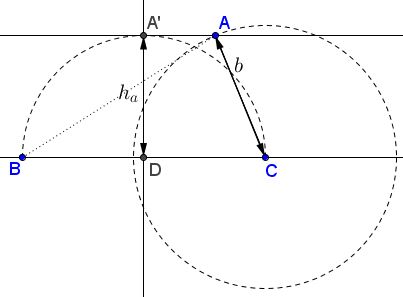The many ways to construct a triangle II
hc, lc, mc

Assume the triangle ABC is given and draw its circumcircle. Draw also hc, lc, mc. Extend lc to the intersection with the circle at P and connect Mc (I'll write M for simplicity. The same convention applies to Lc and Hc.) Since P is the midpoint of the arc APB and M is the midpoint of AB, MP is perpendicular to AB and, therefore, is parallel to CH. We conclude that CP (the bisector of C) lies between CH and MP. Finally, the foot of the angle bisector L lies between H and M. This is universally true for every triangle.
The center of the circle lies on MP and on the perpendicular bisector of CP. From here we get the following construction:
Form a right triangle CHM. With the center at C sweep an arc of radius lc. If it does not intersect HM between H and M, the construction is not possible. Otherwise we get a point L. Continue CL beyond L and draw a perpendicular to HM at M. The two lines are bound to intersect at P. Draw a perpendicular bisector of CP till it intersects MP at O. With the radius OP draw a circle with center O. Extend HM both directions to obtain A and B.
a, b, A

This is a well known construction and, in principle, the three elements a, b, and A may not define a triangle or may not define it uniquely. When the angle is right the triangle is defined in a unique way.
Draw AC of the given length b and the angle A. The circle of radius a and centered at C may intersect the other leg of A either at two points B', B", at one point B (it will actually touch AB) or not at all. When the point of intersection is unique the angle B is right. If this is known in advance, we may use a different approach.
If B is right, AC is the hypotenuse of the triangle ABC. Its midpoint serves as the circumcenter of the triangle. Draw AC and a circle with diameter AC. From C draw an arc with radius a.
ha, b, c

Draw two parallel lines ha (units) apart. Pick a point A on one of them and from this point and with the center at A draw arcs of radii a and b till they intersect the other line. The problem may have no solution (e.g., b<ha or b<ha). Otherwise, it may have one solution (b=ha or c=ha). And lastly, it may have two solutions ABC' and ABC" as indicated in the diagram.
aa, Hb, Hc

Triangles BHbC and BHcC are both right. Therefore, the two given points Hb and Hc lie on the circle with diameter BC. The perpendicular bisector of the segment HbHc passes through the center M of this circle. This suggests the following construction:
Find the point M at the intersection of aa and the perpendicular bisector of HbHc. Draw a circle centered at M through either Hb or Hc. Extend BHc and CHb until they intersect at A.
Second Construction (Barukh Ziv)

Recalling the mirror property of the orthic triangle, we conclude that angles BHaHb and CHaHb are equal. This suggests the following construction. Join points Hb, Hc. Reflect Hb in aa, call the image Hb'. Then intersection of HcHb' with aa is point Ha. Bisector of the angle HbHcHa intersects aa at point C. Through point Hc draw a perpendicular to HcC, which intersects aa at B. Finally, the intersection of BHc with CHb is point A.
a, hb, lc
Draw an auxiliary triangle BCHb and the bisector of the angle C. On this bisector, select Lc so that CLc = lc. Extend BLc and CHb until they meet at A.
ha, hb, c
Draw an auxiliary triangle ABHb and the circle with radius ha centered at A. Draw a tangent from B to the circle. Extend the tangent and AHb until they meet at C.
A second solution starts with a circle, say, ω on c as a diameter. One of the endpoints id naturally A, the other B. Draw circles
C(A, h_a) andC(B, h_b) and find their intersections with ω. These will be the feet of the altitudes Ha and Hb from A and B, respectively. C lies at the intersection of BHa and AHb.a, b, ha

Let BC = a. Draw a line parallel to BC at distance ha. Sweep an arc with center C and radius b. This will intersect the line in the sought vertex A.
ha, hb, mc

Assume the triangle ABC has been constructed. From Mc drop a line McH' perpendicular to CB. Then McH' is half ha. This suggests the following construction:
First construct the right triangle CMcH' with McH' = ha/2 and hypotenuse CMc = mc. CH' defines the line aa. Similarly, on the other side of CMc find the line bb. Extend CMc to twice its length to get the point D from which draw lines parallel to aa and bb to obtain A and B, respectively.
|Contact| |Front page| |Contents| |Triangle constructions|
Copyright © 1996-2018 Alexander Bogomolny71535616
